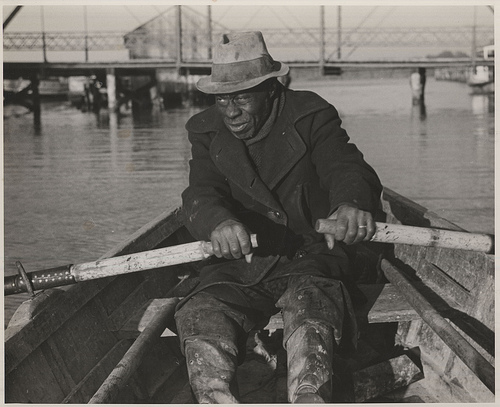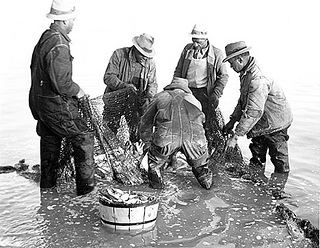Coastal Life
"Homegrown Skills: Creating a Way of Life at the Coast"
by Karen Willis Amspacher
Reprinted with permission from the Tar Heel Junior Historian. Fall 2009.
Tar Heel Junior Historian Association, NC Museum of History
See also: Our State Geography in a Snap: The Coastal Plain Region
 Life at the coast in 2009 greatly differs from what it would have been one hundred, fifty, or even twenty-five years ago. These days, the modern conveniences of communication, transportation, and commerce are readily available to everyone who visits or lives along the coast of North Carolina. But throughout history, people there have depended on the coast’s natural resources—beautiful and productive waters, abundant seafood, and wintering grounds for waterfowl—to survive.
Life at the coast in 2009 greatly differs from what it would have been one hundred, fifty, or even twenty-five years ago. These days, the modern conveniences of communication, transportation, and commerce are readily available to everyone who visits or lives along the coast of North Carolina. But throughout history, people there have depended on the coast’s natural resources—beautiful and productive waters, abundant seafood, and wintering grounds for waterfowl—to survive.
In the past, certain skills existed that were very important to a coastal family’s way of life. Income and survival depended on these skills and the ability to use the waters nearby. A community’s food traditions relied on the area’s natural resources. Even a young person’s entertainment and fun would be based on their knowledge and skills. For example, in the early 1900s, a teenager would need to be able to handle a boat to go on a date in another community. There were no roads or bridges to get from place to place in many parts of the coast. A young boy’s winter fun might be hunting waterfowl along the coastal marshes, which required knowing how to shoot, how to handle a boat, and maybe even knowing how to make decoys.
One hundred years ago in North Carolina’s coastal communities, hunting and fishing supplied a family’s food and income. It was important to have hunting skills; to know about waterfowl like ducks and geese and their habits; to understand the ways of fish and how to catch them; to know where to find oysters and clams; to grasp how to handle (and even build) a boat; and to know plenty about local waters, feeding grounds, and navigation channels. People needed carpentry skills to build a house for shelter and a boat for transportation. Creativity and ingenuity, along with basic know-how, could make life easier and more enjoyable in many ways.
The Tar Heel coast looked very different as late as the 1930s, 1940s, and 1950s. The region featured great expanses of marshes, creeks, rivers, and sounds scarcely touched by humans. Roads and bridges had not yet come to every area, so everything (including people) was still moved around by boat. Each neighborhood had its own store, and doctors came in boats to treat the sick. Communication usually meant one telephone in the local store, with a radio in almost every home. It took work and effort to get anything. Life centered on family, school, and church. Children grew up in a limited world.
After World War II, in the mid-1950s, life started to change. Coastal communities began to shift from “living off the land and the local waters” to a more diverse economy. More and more people moved into the area. Vacationers found the unspoiled waters and open beaches. More jobs with the government—such as the Coast Guard, teaching, civil service, and state agencies—mixed with the traditional coastal trades of commercial fishing, boatbuilding, hunting, and local commerce, such as running small stores and other businesses. Women joined the workforce and helped provide families with money to buy food and other needed items.
 Even traditional coastal occupations began to change, becoming more trade oriented and specialized. Men became boatbuilders, decoy makers, net hangers, fishermen, and hunting guides—and most times, a combination of those roles. Coastal communities’ economies continued to depend on these skills, but men usually focused on certain trades to make a living instead of using several skills just to provide for their families.
Even traditional coastal occupations began to change, becoming more trade oriented and specialized. Men became boatbuilders, decoy makers, net hangers, fishermen, and hunting guides—and most times, a combination of those roles. Coastal communities’ economies continued to depend on these skills, but men usually focused on certain trades to make a living instead of using several skills just to provide for their families.
In the 1980s, coastal economies shifted even more toward tourism (or travel) and becoming retirement destinations. Traditional skills are gradually becoming harder to find. Most people view commercial fishing as a dying industry. Wooden boats used for working the waters are being replaced by recreational and sportfishing styles of boats. Waterfront homes, condominiums, and businesses suited to travelers and new-home buyers are replacing working fish houses, boatyards, and harbors.
Still, traditions like commercial fishing, boatbuilding, hunting and fishing, decoy carving, and net hanging—and the creative men and women who work in these trades—remain important to North Carolina’s cultural heritage. Today, such heritage skills are most often featured in museums, tourism programs, and festivals that remind us of how much the coast has changed in just the last few decades. The value of these skills continues to grow, because abilities that define Tar Heel coastal traditions provide an important link to the past that should be passed on to the next generation.
Decoy Making
“Decoys are my way of holding onto the past.”
—Joe Fulcher Jr., third-generation decoy carver
For many years—centuries, perhaps—waterfowl such as large flocks of redheads, canvasbacks, blackheads, pintails, and geese spent the winters along North Carolina’s coast, especially in places like Currituck and Core sounds. These birds became a major food source for people living in the region. The tradition of hunting created a need: decoys. Decoys are man-made replicas, or models, of ducks and geese that are made to float and look like real birds.
Decoys provided an important tool for hunting. These wooden ducks were placed in the water to lure live birds to land in the creeks and marshes. Hunters watched from a duck blind nearby. (A duck blind is a small hideout for the hunter; adapting the blind to the hunter’s needs offers another example of Tar Heels’ creativity. A blind is usually a small shack, sometimes resting on posts over the water and sometimes built into the marsh close to hunting grounds.) The goal for using decoys was to get live ducks and geese close enough for hunters to shoot them.
Again, the mid-1900s brought change to this tradition. For most people, hunting changed from being a way to put food on the table to being a sport. So the way that people made decoys changed, too. People bought plastic decoys from catalogs and stores. These manufactured (instead of handmade) decoys were lighter and easier to handle. They began to replace the old wooden decoys.
Making decoys then became more of a folk art than a survival skill. Decoys became collectors’ items rather than tools. This was another way that the coastal culture changed to meet new opportunities. The creative waterfowl lover could become an artist rather than a hunter. Carvers could make money by creating decoys for a new audience, and decoys became even more detailed and beautiful.
Like other everyday activities that become old-fashioned as lifestyles change, the practice of turning wood into ducks could have been taken for granted, ignored, or forgotten, had it not been for people who appreciated this skill as part of their coastal heritage. Today, artists who make decoys join in heritage cele-brations and events, are featured at places like the Core Sound Waterfowl Museum and Heritage Center, and share their skills with young people. They are making sure that coastal traditions will continue to survive.
Boatbuilding
“If she ain’t pretty, she won’t work right.”
—Calvin Rose, Harkers Island boatbuilder
North Carolina has a long and winding coastline. Along the coast, the land borders creeks, rivers, and sounds, while the Outer Banks meet the Atlantic Ocean for hundreds of miles. Counties up and down the coast—ranging from Dare to the north and Brunswick to the south—have economies that were historically tied to the waters surrounding them through commercial fishing and boatbuilding.
For instance, along the central coast, Carteret County includes more water than it does land: 821 square miles of water compared to 520 square miles of land. Even that land is filled with creeks and rivers. Is it any wonder that boatbuilding has been so important throughout the county’s history? Boats had been needed for transportation in the early years and for food (including commercial fishing for generations). Now they are needed as part of a growing tourism industry.
According to Sonny Williamson in Sailing with Grandpa—a local publication highlighting the history of working sail skiffs along North Carolina’s central coast—boatbuilding first grew into a business in the late 1800s. That meant that boats became more than a part of subsistence living—in which each household or family raised or caught its own food, needing a boat to get from place to place in order to have something to eat. Boatyards and shipbuilding operations appeared along the coast to support the growing ocean trades and provide boats for commercial fishing, in which people sold what they caught.
Boat styles have developed over the generations, beginning with the sharpie, a type of sailing skiff. This boat came south from the Chesapeake Bay with oystermen who arrived to work North Carolina waters in the early 1900s. Changes were made to the sharpie’s design over generations. For example, Tar Heel builders adjusted for North Carolina’s shallow waters by adapting the design of the boat’s bottom. They created ways to have larger sails, so the boats could go faster and work better in the sounds between the mainland and the Outer Banks.
With the coming of gasoline engines in the mid-1900s, builders put aside the sharpie sail skiff for new, larger, and more efficient ways to move people and goods. Mail boats, freight boats, and commercial fishing vessels lined the docks of places like Ocracoke, Hatteras, Wanchese, and Sneads Ferry. Boats were important to everyone—carrying doctors, groceries, preachers, servicemen, and families from community to community, especially in rural areas where roads and bridges did not even begin to appear until the 1930s and 1940s.
Today’s boatbuilding industry has followed changes in the coastal landscape, economy, and culture. More builders focus on recreational and sportfishing boats that cater to tourists instead of working fishermen. Materials have changed from wood to fiberglass. Most boats are manufactured using machinery instead of being made by hand. A strong love for handmade wooden boats remains, however. Events, classroom programs, and small businesses along the coast of North Carolina and other states focus on traditional boatbuilding. The practice was important to the past and remains crucial to the region’s economy, history, and traditional culture.
*At the time of this article’s publication, Karen Willis Amspacher was serving as the executive director of the Core Sound Waterfowl Museum and Heritage Center on Harkers Island. She edited several books related to coastal heritage and history, including The Mailboat, Island Born and Bred, and Morehead City Heritage Cookbook.
Image Credit:
Unidentified man involved in anchor gill net fishing, Edenton, c.1939. From the Charles A. Farrell Photograph Collection, PhC.9, North Carolina State Archives, call #: PhC9_2_56_4. Available from https://www.flickr.com/photos/north-carolina-state-archives/2456761817/ (accessed December 20, 2012).
"Brickle, Edenton, Shad and Herring fishing n.d. (1935-1940). From the Charles A. Farrell Photograph Collection, PhC.9, North Carolina State Archives, Raleigh, NC, access #: PhC_9_2_58_11a. Available from https://www.flickr.com/photos/north-carolina-state-archives/6843326405/ (accessed May 31, 2012).
1 January 2009 | Amspacher, Karen Willis